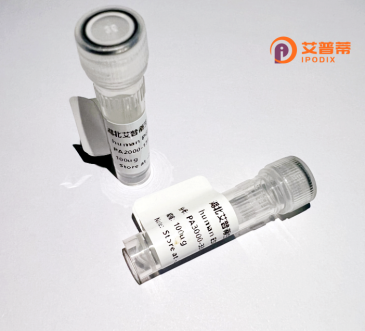
| 纯度 | >90%SDS-PAGE. |
| 种属 | Human |
| 靶点 | TRIM71 |
| Uniprot No | Q2Q1W2 |
| 内毒素 | < 0.01EU/μg |
| 表达宿主 | E.coli |
| 表达区间 | 1-868 aa |
| 活性数据 | MASFPETDFQICLLCKEMCGSPAPLSSNSSASSSSSQTSTSSGGGGGGPGAAARRLHVLPCLHAFCRPCLEAHRLPAAGGGAAGEPLKLRCPVCDQKVVLAEAAGMDALPSSAFLLSNLLDAVVATADEPPPKNGRAGAPAGAGGHSNHRHHAHHAHPRASASAPPLPQAPQPPAPSRSAPGGPAASPSALLLRRPHGCSSCDEGNAASSRCLDCQEHLCDNCVRAHQRVRLTKDHYIERGPPGPGAAAAAQQLGLGPPFPGPPFSILSVFPERLGFCQHHDDEVLHLYCDTCSVPICRECTMGRHGGHSFIYLQEALQDSRALTIQLLADAQQGRQAIQLSIEQAQTVAEQVEMKAKVVQSEVKAVTARHKKALEERECELLWKVEKIRQVKAKSLYLQVEKLRQNLNKLESTISAVQQVLEEGRALDILLARDRMLAQVQELKTVRSLLQPQEDDRVMFTPPDQALYLAIKSFGFVSSGAFAPLTKATGDGLKRALQGKVASFTVIGYDHDGEPRLSGGDLMSAVVLGPDGNLFGAEVSDQQNGTYVVSYRPQLEGEHLVSVTLCNQHIENSPFKVVVKSGRSYVGIGLPGLSFGSEGDSDGKLCRPWGVSVDKEGYIIVADRSNNRIQVFKPCGAFHHKFGTLGSRPGQFDRPAGVACDASRRIVVADKDNHRIQIFTFEGQFLLKFGEKGTKNGQFNYPWDVAVNSEGKILVSDTRNHRIQLFGPDGVFLNKYGFEGALWKHFDSPRGVAFNHEGHLVVTDFNNHRLLVIHPDCQSARFLGSEGTGNGQFLRPQGVAVDQEGRIIVADSRNHRVQMFESNGSFLCKFGAQGSGFGQMDRPSGIAITPDGMIVVVDFGNNRILVF |
| 分子量 | 121.9 kDa |
| 蛋白标签 | GST-tag at N-terminal |
| 缓冲液 | PBS, pH7.4, containing 0.01% SKL, 1mM DTT, 5% Trehalose and Proclin300. |
| 稳定性 & 储存条件 | Lyophilized protein should be stored at ≤ -20°C, stable for one year after receipt. Reconstituted protein solution can be stored at 2-8°C for 2-7 days. Aliquots of reconstituted samples are stable at ≤ -20°C for 3 months. |
| 复溶 | Always centrifuge tubes before opening.Do not mix by vortex or pipetting. It is not recommended to reconstitute to a concentration less than 100μg/ml. Dissolve the lyophilized protein in distilled water. Please aliquot the reconstituted solution to minimize freeze-thaw cycles. |
1. **"TRIM71 Cooperates with microRNAs to Repress Cdkn1a Expression and Promote Embryonic Stem Cell Proliferation"**
*作者: Loedige I. et al. (2013)*
摘要:研究揭示了TRIM71通过与Argonaute蛋白互作,增强miRNA介导的mRNA沉默,促进胚胎干细胞增殖,并抑制细胞周期抑制因子Cdkn1a的表达。
2. **"Structural Basis for the RNA-Binding Activity of TRIM71 in Gene Silencing"**
*作者: Chen Y. et al. (2012)*
摘要:通过解析TRIM71的RNA结合结构域晶体结构,阐明了其识别并结合特定RNA序列的分子机制,解释了其在发育过程中调控基因沉默的分子基础。
3. **"TRIM71 Drives Hepatocarcinogenesis by Suppressing Tumor Suppressive miRNAs via Ubiquitination of Ago2"**
*作者: Liao Y. et al. (2019)*
摘要:发现TRIM71在肝癌中过表达,通过泛素化修饰Argonaute2(Ago2)破坏抑癌miRNA的功能,促进肿瘤细胞增殖和转移,提示其作为肝癌治疗靶点的潜力。
4. **"TRIM71 Coordinates Stem Cell Differentiation via Degradation of let-7 microRNA Precursors"**
*作者: Rybak A. et al. (2009)*
摘要:证明TRIM71通过结合并降解let-7 miRNA前体,维持胚胎干细胞的未分化状态,调控发育时序,揭示其作为RNA结合蛋白在发育中的关键作用。
TRIM71 (Tripartite Motif-Containing Protein 71) is a multifunctional RNA-binding protein belonging to the TRIM family, characterized by conserved RING, B-box, and coiled-coil domains. Initially identified for its role in embryonic development and stem cell maintenance, TRIM71 regulates gene expression at post-transcriptional levels by binding to target mRNAs, influencing their stability and translation. It acts as an E3 ubiquitin ligase, mediating protein ubiquitination and degradation, and interacts with components of the miRNA pathway, including Argonaute proteins, to modulate RNA silencing.
Studies link TRIM71 to cancer progression, where it often exhibits aberrant expression. It promotes tumorigenesis in hepatocellular carcinoma, glioblastoma, and lung cancer by enhancing cell proliferation, inhibiting apoptosis, or activating oncogenic signaling pathways. Conversely, its role varies context-dependently, showing tumor-suppressive effects in certain malignancies.
TRIM71 also contributes to neurodevelopmental processes, with mutations associated with congenital brain malformations. Its involvement in cellular reprogramming highlights its potential in regenerative medicine. Despite advances, precise mechanisms underlying its dual regulatory functions—balancing mRNA decay/translation and mediating protein ubiquitination—remain under investigation, making it a compelling target for therapeutic and developmental research.
×